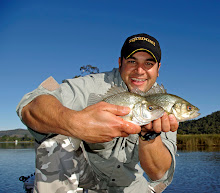



Fishing is a unique sport. Technology plays a huge part in the overall popularity of what's in vogue, what's considered old and what is determined a must-have. Lures are probably subject to most of this hype. Now i say hype cause thats exactly what it is. In my opinion all lures catch fish, in the right hands of course, but lures are not all created equal. Lets see what i mean...
First of all most lures that are becoming the modern go-to lures, and especially so in tournaments, are really only a rehash of an old design. Add a new rattle, some holographic colours and new packaging and 'wallah' new gun lure. This is typified by the current bladed lures on the market now e.g TT Lures Switchblades and Ecogear VX-35's... These things are the must-have in the arsenal of a bream luring fisho. The fact is they have been around since adam was a boy. Bladed lures were somewhat more 'agricultural' than what they are now. But as i suggested thats the whole premise. Get an old design and tweak it a little then market it as the latest and greatest.
What extent is this hype manufactured and what is real??? Do they really catch more fish than the lures that came previous??? My theory is that a successful lure is always a successful lure. By that i mean no lure dies in potency. It's all about ratios. If three quarters of the fishing population start to use a hyped lure most of the time the reality is they are not using another lure most of the time. Remember this point, you will catch most fish on a lure that is in the water the most time. Simple. A successful lure will never be the one gathering dust in your box. But pull that lure out and fish with it most of the time and see what happens.
Same with plastics. The sp's i was using 3 years ago will still work today. Just that since then i have acquired other gun sp's and rarely dig around to the older ones. Give a lure time to work and it will work.
These ideas do come with some conditions of course. Dont pull out a lure meant for flatties and try and catch a bream. It will eventually work but not the same as a lure designed for a certain species.
Its not all marketing though. New lures do come along. The new hybrid lures that utilise both hardbody and soft body ideas are an interesting phonomenon. Still getting my head around it all. Not convinced.
So don't get caught up in the tackle industry machine...its hard to get out, trust me i know better than most. Don't try and keep up with the Jones', who cares if high profile fishing 'experts' are raving on about this lure or that. Take it with a grain of salt. Work it out for yourself. Otherwise you just end up having a great collection of redundant lures capable of catching fish yesterday!


